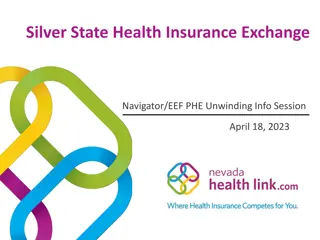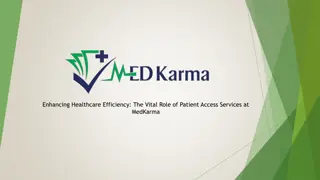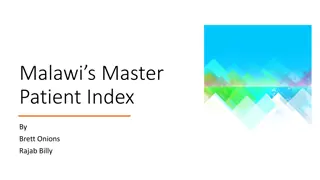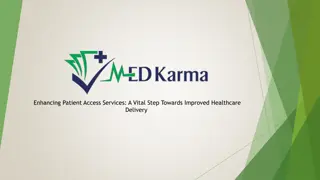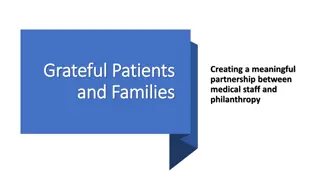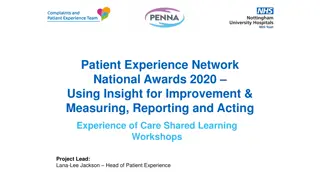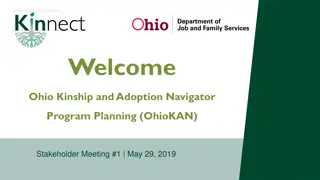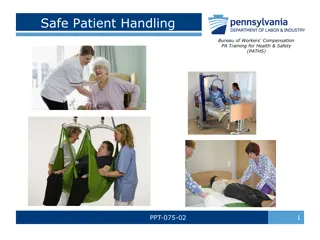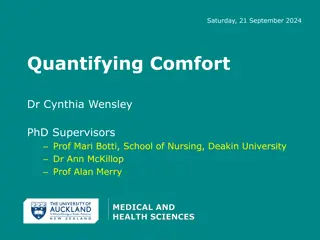Patient Financial Navigator Foundation: Transforming Healthcare Experience
The Patient Financial Navigator Foundation aims to transform the healthcare experience by providing education and support to patients, families, employers, and communities. Through free resources, events, and advocacy, the foundation navigates the financial challenges in healthcare, empowering individuals to be advocates for themselves and their loved ones. The foundation also focuses on personalizing healthcare and improving communication between patients, families, and healthcare providers to ensure a smoother experience.
Download Presentation

Please find below an Image/Link to download the presentation.
The content on the website is provided AS IS for your information and personal use only. It may not be sold, licensed, or shared on other websites without obtaining consent from the author.If you encounter any issues during the download, it is possible that the publisher has removed the file from their server.
You are allowed to download the files provided on this website for personal or commercial use, subject to the condition that they are used lawfully. All files are the property of their respective owners.
The content on the website is provided AS IS for your information and personal use only. It may not be sold, licensed, or shared on other websites without obtaining consent from the author.
E N D
Presentation Transcript
LIVING THE PATIENT EXPERIENCE BE THE PATIENT HEALTHCARE IS A BUSINESS BUT NOT TO THE PATIENT OR THEIR FAMILY PATIENT FINANCIAL NAVIGATOR FOUNDATION S MISSION - TRANSFORMING THE HASSLE FACTOR ONE PATIENT, ONE FAMILY, ONE EMPLOYER, ONE COMMUNITY AT A TIME .THRU EDUC ATION 1
PAYING IT FORWARD THE POWER OF ONE WE CAN MAKE A DIFFERENCE ISN T THAT WHY WE ARE IN HEALTHCARE? In 2017, we formed an Idaho-based, Family Foundation: The Patient Financial Navigator Foundation Pfnfinc.com All material Free! Mission: To transform the hassle factor in healthcare one patient, one family, one employer, one community at a time thru education. Host regional 3x yearly Medicare 101, Social Security and Assistance for Seniors Boot camp. NO cost. Working with many local healthcare contributors/faculty and the local college. Write Health Care Buzz for a regional newspaper Continue to reach out to employers Wellness Luncheons and the Small Business Groups Highlight Women in Leadership - Celebrate! High school seniors next generation of engaged healthcare adults. Need taught! Free webinars and speaking to associations on how they can be the change makers free! Be the example you want healthcare to look like The power of One.. Creativity! 2
HEALTHCARE IS PERSONAL. WALK THRU THE INTERNAL REVENUE CYCLE AND LOOK FOR WHERE PATIENTS GET LOST. What about the ongoing conversation what is happening? Let s look inside beyond the initial crisis of the moment and see what healthcare looks like To the Patient To the Family What happens now? Ps just because a family is present, they are easily highly upset and just as lost as the pt. Patients don t access hospitals rarely. All new! Patients come to a healthcare provider Scared, their live has been disrupted and they don t know where the money will come from to pay their medical bills. Once the patient is ill or has had an accident, all energy is with the patient and family. Who is the advocate to help them navigate the internal systems? How will they even know? Lost and scared. 3
1) THE PATIENT ARRIVES IN THE ER. FAMILY OR A FRIEND OR MAYBE THE PT CAME ALONE All the admission forms need completed. Nursing has to do a complete assessment. The doctor/mid-level re-asks just to be sure it was complete. Time passes while the pt is waiting to hear what is wrong? Tons of pain.. Scared. When the results finally come back, - good, you can go home/see your primary care doctor/discharge instructions. (what if the pt doesn t understand?) Get your prescription and thanks for coming! (A little humor!) OR - they are accepted by the hospitalists another stranger to the pt. They are told they are being admitted to the hospital pending approval by their insurance. WHAT? 4
2) NOW THE PATIENT IS AN INPT OR IS IT OBSERVATION AND WHAT DOES THAT MEAN TO THE PATIENT? WHAT IS A HOSPITALIST? This is when it gets extremely difficult to be a patient in the healthcare system. Another complete nursing work up, another doctor asking the same questions, another set of new forms/The Important Medicare, moved from the ER eventually to the floor. Placed in room 204. (How would the pt know they are OBS today vs inpt? They are in room 204. Insurance pays differently.) Who is this hospitalists ? Where is my doctor? I would feel more comfortable with my primary care/internal medicine doctor who I have known for years. Hospitalists can be assigned all medical pts, some surgical, rarely peds or OB and they change approx. every 4 days/with approx. 25 pts ea. The continuity to the patient and family is questionable. Each time, if feels like the pt is starting over. (Paper vs EMR is there a big difference at the bedside?) And what if the family comes at 5:30 p.m and would like to see the hospitalists the wait begins. Who can help the patient s family rapidly to understand what is happening to their loved one? Nursing has severe limitations on what they can share. You will have to ask the doctor. 5
3) NOW THE CARE PLAN FOR TREATMENT BEGINS Care plans are created with a very high level review given to the pt who just came from the ER. Hopefully they have friends or family with them. Who understands what is happening and why this course of treatment is being recommended? What if it doesn t work? How will the pt know /family know? They are scared and not comfortable with the healthcare words that are being used. Don t want to appear stupid so just shake their head Who can be asked about the coordination of care and what can be expected? Again, bedside nursing is always the first point of contact, but many times have to try to see a doctor. Can appointments be made ? Doctors rounds are not known to the family or support system. People have jobs so how can this be coordinated to reduce concern and improve buy-in? Aftercare and family support only happen with ongoing feedback fear creates anger. 6
4) NOW IT IS TIME TO DISCUSS DISCHARGE Patient has been in the hospital for 2 days. Everyone is talking when you go home and the pt is thinking- I sure hope I can go home. Who is going to help me as I live alone? Or my family all have jobs and I really need to get back to work asap wow! Who is counseling with me about my insurance or lack of insurance? Can someone discuss how much this is going to cost? Who can explain my insurance package? Man, oh man, I remember the HR and insurance agent walking thru all this but it was way above my head. Now I need help! Discharge instructions include some great clinical follow up but what about my bill? Where is the onsite Financial Navigator who can reach out to each family/pt and arrange a no surprise visit while the pt is in-house? Contact the family, make an appt, talk finances. If not when they are in-house, then when? (No pre-admission for ER visits. PS are you still doing a financial pre-admit visit?) You will need 24/7 care for about 2 weeks. What? I can t pay for that..where is that money coming from? . Oh yeah, I have Medicare.. It pays for everything. (a little more humor) 7
5) NOW THE POST DISCHARGE ANGUISH Physical therapy is ordered. Your preferred provider in your network but not part of the hospital s Electronic medical record network. The hospital may connect with all the healthcare providers pharmacy, PT, community providers, Home health, DME, SNF, etc to send them access to look up info on the patient . But there is seldom a way for the healthcare provider to send back to the main electronic record. Your primary physician is part of a one network/EMR so there is no way to get all the healthcare updates back Oh yeah the provider said you can take the records and give them to your provider. WHAT? Huge patient disruption with the lack of interoperability sharing back and forth. Avoids duplication, poor coordination of care, better patient access of updated info WHY NOT? PS Some state have mandated Interoperability. . Love it! But do we really need to have a law to force us to step up and coordinate on behalf of the pt? Social Determinants of health= Public Health 8
MORE COMPLICATIONS TRANSFERS OUT OF NETWORK Patient deteriorates. Time to transfer to a higher level of care. Now new bills from another healthcare provider. New care givers, start over again with all the interview questions, insurance, paperwork wow! Out of network? What? Isn t this an emergency? How would the family know to ask: did you check with my insurance to ensure you are in our network? The daughter is placed in NCCU what is my priority? Insurance denies. Did the transferring hospital contact the family to discuss out of network and what they were doing on their behalf? Which pt/family member knows how to battle the out of network denials? HINT: Hospital may be covered- pt portion should be in-network rates. But what about all the interps and all the consulting physicians? If employees, should be auto covered. If not, Surprise Bills! When the payer denies, who is helping the pt fight to get the healthcare provider paid? Where is the patient financial navigator advocate? (SW knows some, but not the guts of the insurance world and who is the contact for the family/pt to reach out to when the insurance starts denying?) No patient/family knows how to work within the insurance /healthcare provider MAZE. And then bad debt happens. (500,000 pts declared bankruptcy in 2018 1 in 6 families have a healthcare bad debt. What does a pt financial navigator cost?) 9
WORDS OUR COMMUNITY DOESNT UNDERSTAND DREADED WORDS: OUT OF NETWORK & SURPRISE BILLS We don t understand our insurance package until we need it. Out of network UGLY Usually pt pays a) full billed charges, b) a 2nd deductible is due. Surprise bills the patient had no way of knowing that a) ER provider, b) consulting providers, c) radiologist /pathologist/cardiologist doing interprets, d) reference send outs = all done during the inpatient stay in an in-network facility. ( 1 in 6 tell of surprise bills .) Hold the patient harmless - what does that mean? (EX. Will the ER billing office/etc. know the in-network rate for 99284 and only bill the pt the correct amt? Where will this information come from? How will any patient even know what to ask??) Rate setting, arbitration based on $ amt disputed (Ex $1200) PS Why are hospitals allowing providers who work with them to not be in their network? ER providers? Pathologist? Reference labs? Rad doc? The consulting providers are more difficult but the hospital has to do a better job in a) educating their public or in-network and b) demanding to know why all these direct- relationship providers are not in the same network and b) TAKE YOUR POWER BACK and do some conversations as a provider block and then discuss contracting with the payers. The payers need you too 10
OUT OF POCKET COSTS AND PREMIUMS UP 67% FROM 10 YEARS AGO. KAISER FAMILY FOUNDATION 9-19 Ave family of 4 paid $7,726 in premiums and cost-sharing payment in 2018. Up 67% from 10 years ago. In comparison, employers spent an average of $15,159 per family of 4 on premiums. Up 51% from 10 years ago. For employees, the cost of coverage has outpaced wage growth. Wages have gone up 26% over the past 10 years. Healthcare costs up 67% to the pt. In addition, deductibles now reflect more than /50% of the worker s out-of-pocket spending. In 2008, deductibles accounted for 26%. Concern: Real cost to the pt from in-network rates vs billed charges. Option ideas: Increase use of Health Saving s accounts/HSA (only allowed with high deductibles/$3500) but beware of how it is funded and how the insurance plans apply it. (EX. No copayments apply. MEANS = pay full charges for doctor s appts. What??) 11
PRIOR-AUTHORIZATION 2ND MOST DREADED WORD TO THE PATIENT/PROVIDER Insurance Directed Care vs Physician Directed Care. Value based care means? So only care that the payer has determined is Value Based is approved. Who made these determinations? EX) MRI is not approved as the payer has hired a company to determine value based alternative care to the MRI. 4 weeks of PT first.. 50% of all plans are now high deductible/$3500. All out of pocket to the pt. Prior authorization Congress had hearing recently. Physicians gave testimony about the massive cost of redundant prior authorization for services. Great recommendations about payers creating list of high risk /high cost and only do these. Once approved, why have to do each visit/course of treatment? Congress replied with more automated sending of records, less faxing. WHAT? AMA 1000 physicians, 14 hrs. weekly trying to get auth. Had they asked the hospitals how many hrs. are spent trying to a) get inpt approved and b) updating authorizations when a test or surgery is changed AFTER the initial auth and YEP DENIAL after receiving the prior auth. How many more hrs.? PS with the Affordable Care Act no pre-existing exclusions can be applied by the payers. But what if it is repealed? Now think Prior auth? Now think denials for pre-existing? 12
OUR SENIORS TRADITIONAL/ORIGINAL MEDICARE VS. MEDICARE ADVANTAGE It is all about the money! 50% of all seniors are living on Social Security. Aver $1300 women/$1550 men. Part B premium $135/aver; Part D premium $65/aver. = $200 monthly premiums out of the SS $. If they get a supplemental plan to cover the out of pocket expenses add another $180 monthly = $380 EACH. In walks Medicare Advantage - TV ads for Humana/$0 monthly premiums. United/$38. Blue Cross/$29. Starts the conversation ends the conversation. Gives the pt $150 more to live on. They will have an out of pocket as no supplement, but Much less $ than with traditional Medicare frozen amts for tests, etc. Social Determinant of Health- old news for MA plans. The provider network is huge to the Senior. Hospitals, SNF, doctors. But staying in the network is the only way to have real savings Many times new providers are required. Visiting family, vacations, snow birds = lots of potential for out of network. PS Always use an agent to do a drug tier search prior to picking any Part D plan in Traditional or MA plans. Ugly drug cost surprises! Changes yearly (Open enrollment now!) 13
FINALLY THE BILL BIGGEST SURPRISE BILL OF ALL! Patient gets an itemized statement (right?) who do they call to have it explained? Remember, high deductibles = $3500 first, then 80/20 or 70/30 pt pays. Multiple of bills come to the pt hospital, or surgeon or ER provider or Rad doc or pathologist or anesthesiologists or . And then the payer sends their EOB. Who can explain to the pt how to read these? The payer tells you to call the provider with questions. The provider tells you to call the payer. Just go our portal and you can see everything plus just pay us with your credit card. If this is a recurring bill, very good option. All already understood. But otherwise . Scared, didn t ask to have this bill, don t understand the charges, don t know why so many different rules for each payer, why so many different bills/who can explain all of that/ don t these doctors work for the hospital/why separate statements? .and on and on . What is a Charge master? Charges don t represent the price you will pay? WHAT? Each payer has their own contracted amount/insurance specific. The pt needs to know their payer s amount that is allowed, per CPT code, so the pt can make an informed decision. Not billed charges. 14
LAST THOUGHTS - THE EXCHANGE/MARKETPLACE Affordable Care Act if we loose the ACA, we will loose the state exchanges. Much more than individual market. Who is navigating/doing community ed on how to use these? Many do not understand a) what is offered or b) how to access. Insurance companies have higher risk as no history with the employer .as all individual. EX) Early retirees. 62 worked 35 years. Retiring with full package. But no insurance until 65 unless he wants to pay COBRA/full premiums. Go to the exchange get an individual package which may have even get subsidies with the premiums due to lower income. EX) Self employed. EX) Small family business EX) Less than 50 employees. 92% of all employers have less than 50 employees. Many less than 25. How are they affording to get insurance? EX) Employee retires at 66/moves to Medicare. But what about the spouse? 15
Idahos Rural Community Hospitals 8 of 27 hospitals are financially viable, per IHA, 2018
WE CAN BE THE CHANGE WE WANT TO SEE.. BE THE PATIENT. Healthcare bills are unsecured loans Why would a patient pay their healthcare bill? What is going to be re-possesed? Relationships matter in debt payment. Having an in-house FINANCIAL NAVIGATOR is powerful and will net results. Are you in a competitive environment? What will make you unique? An in-house financial navigator. Rounds on the floors tells the family HERE IF YOU WANT TO TALK. Hand outs letters with dedicated NAVIGATOR number for questions on bills, etc. When discharged, moves to a COORDINATED financial counselor who READS the notes from the in-house, helps coordinate a payment plan, BUILDS on the relationship built in-house. True coordination of care eliminate financial surprises Ask your patients Especially problematic with the multiple MERGERS, outsourcing of BO functions, etc. 17
THANKS FOR JOINING US IN THIS EDUCATIONAL JOURNEY Day Egusquiza, President AR Systems, Inc Patient Financial Navigator Foundation, Inc. PO Box 2521 Twin Falls, Idaho daylee1@mindspring.com Http://arsystemsdayegusquiza.com Pfnfinc.com Not-for-profit Foundation Patient Financial Navigator Foundation, Inc A family owned, Idaho-based foundation formed in 2017. Transforming the hassle factor in healthcare thru Education. 18




